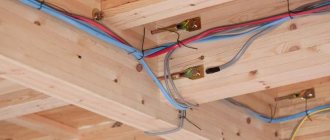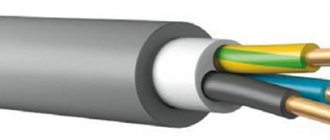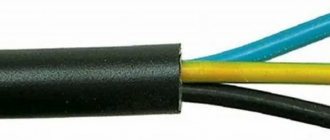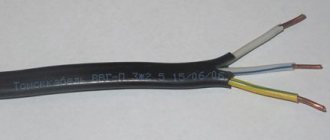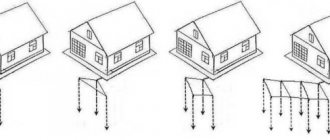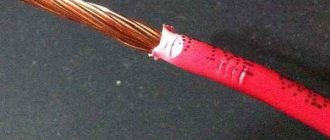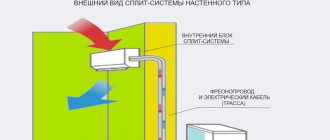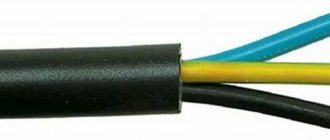There are a variety of wires on sale, differing in material, cross-section, marking, design and color.
When laying electrical systems, it is necessary to resolve the primary issue - which cable to use for wiring in the apartment in order to ensure the safety and reliability of the laid electrical communications.
Agree, choosing a suitable conductor is not an easy task. We will try to help you, and we suggest you familiarize yourself with the detailed classification of cables and the specifics of connecting electrical equipment.
Reasons for replacing cables
Complete or partial replacement of electrical networks usually needs to be performed in two cases:
- Wiring age . Major renovations are recommended to be carried out 15-20 years after moving into a new apartment. During this time, the installed communications wear out, becoming a source of potential danger for residents.
- Redevelopment and renovation of premises (especially with the addition of powerful household appliances). Modern electric stoves, washing machines, and dishwashers place increased demands on wiring. It is not advisable to connect them to old electrical networks due to the mismatch of characteristics. When planning to purchase such units, it is better to update communications in individual rooms, for example, in the kitchen or bathroom.
Regardless of the reason for replacing electrical networks, work should begin with drawing up an electrical wiring diagram and selecting cable products.
Differences between cables and wires
Novice craftsmen often ask the question of what to buy for laying electrical communications - cables or wires.
To solve this problem, you need to find out the difference between these products:
- According to GOST 15845-80 adopted in the USSR, the cable consists of one or more conductors (cores) coated with insulating material. Such elements, in turn, are enclosed in a plastic, polyethylene, metal or rubber shell, on top of which an additional protective cover, including an armored one, can be installed.
- Thanks to double insulation, the cable is reliably protected from moisture, light, exposure to aggressive substances, and mechanical damage. Increased strength and reliability characteristics allow the use of such products in the most difficult conditions, for example, under water and underground.
- The wire consists of one or more twisted strands, which can be either insulated or bare. They are usually enclosed in a non-metallic sheath (PVC, cross-linked polyethylene) or a braid/winding made of textile or wire. The security of a wire is much less than that of a cable, so its scope of use is quite limited.
According to professionals, to install a stationary electrical network in an apartment, it is necessary to use only cables. The wires can be used for portable electrical equipment, as well as in low-current systems with a voltage not exceeding 24V.
Wires differ from cables in having bare cores and a lighter protective sheath. They can be used to create electrical systems that do not have high requirements
When choosing materials for laying electrical networks in residential premises, preference should be given to impeccably high-quality products. Only in this case can you install safe, fire-resistant and reliable wiring that will ensure the delivery of electric current to every corner of the apartment.
Main characteristics of cable products
When purchasing materials used for laying electrical networks, you must take into account the following features.
Material used for cable and its design
For wiring, elements with aluminum or copper conductors are used. Aluminum conductors have a lower cost, but copper conductors are more reliable in terms of characteristics: they have a high current conductivity parameter and a lower resistance index. Copper conductors heat up less, which is also an advantage of copper conductors.
Copper is a ductile material and does not corrode quickly, therefore, conductors made of this metal have a long service life.
According to current regulatory documents (SP 31-110-2003, clause 14.3 and PUE 7.1.34), only copper cables and wires should be used for laying wiring in apartments.
Classification by design:
- single-core wires;
- multi-core wires.
An element consisting of one wire is a single conductor with an insulating layer. Installing this type of product does not require much effort. Also, its price is significantly lower than the cost of a stranded product.
Comparing the characteristics of multi-wire and single-wire wiring within a living space, there is practically no difference in the transmission and quality of the electric charge. The only difference is that single-core wire is a more budget option.
Existing types of products
It is difficult to unambiguously answer the question of what wires and cables are needed for wiring in the residential premises of an apartment, since such work requires various types of similar products.
According to current safety regulations, all household appliances and sockets must be grounded. Therefore, in apartments, a three-core cable is installed everywhere, having a “phase”, “zero” and “ground”
For the lighting circuit, which receives the least load from the electrical network, a cable with a cross section of 1.5 mm2 is suitable. For it, it is enough to provide a 10 A (2.3 kW) circuit breaker.
For sockets, the load in which can reach up to 3-4 kW, it is necessary to take products with a cross-section of 2.5 square meters. mm, capable of withstanding current up to 27 A and power 5.9 kW.
However, you should not load the line to such limits: for correct operation, a reserve of one third of the planned load is required. In this case, you will need a switch rated at 16 A (3.6 kW).
If you plan to install an outlet for an electric stove (hob), you need to lay a cable with a cross-section of 6 square meters. mm for power up to 10.1 kW.
In this case, it is important to select an appropriate machine designed for an electric current of 32 A (voltage 7.3 kW).
When choosing the parameters of the input cable to the apartment, it is important to take into account the power allocated to the apartment. As a rule, in this case it is necessary to use a product with a cross section of 6-10 square meters. mm.
As a result
Purchasing a cable for electrical wiring has its own nuances, so the choice of materials must be taken seriously and responsibly. Before purchasing wiring, you need to calculate the loads, determine the location of the sockets and how to run lines to them. A correct and rational approach will allow you to obtain high-quality electrical wiring that will last for decades without failure.
Knowing the listed nuances, purchasing a wire for home wiring should not be difficult, even if a person is not “savvy” enough in technical matters. If the above explanations seem insufficient, then it is better to entrust the choice and purchase to the specialists who will carry out the installation.
Popular types of electrical wiring
Among the frequently used types of products for electrical installation, two common models can be distinguished: VVG and NYM.
Image gallery
Photo from
Wire for electrical installation
Electrical cord for low current lines
Wire for potential equalization
Cable for connecting powerful devices
Option #1 - VVG cable
The most popular domestically produced product, which is often used to perform electrical work in an apartment. The cable belongs to unarmored flexible power wires.
It can consist of 1-5 copper cores, the cross-sections of which vary from 1.5 to 240 square meters. mm. The conductors, which can be round, triangular or flat, are surrounded by polyvinyl chloride insulation and a common sheath.
The VVG cable has several modifications:
- VVG is the main type, the characteristics of which are given above.
- VVGng is a power cable that has an outer sheath and core insulation made of non-flammable polyvinyl chloride.
- VVGng-LS - wiring, the conductors of which have non-flammable self-extinguishing insulation, and the shell has a low smoke emission rate.
- VVGng FR-LS is a non-flammable cable with low smoke emissions, which has additional fire protection made of mica tape.
Although regular VVG is cheaper, its shell does not have fire-resistant properties and emits a lot of smoke when burning. These products are also not suitable for bundle laying, while non-flammable products are mounted in bundles, so that several cable lines can be laid simultaneously in corrugations, pipes or pits.
The same type of product (for example, VVGng cable) produced by different enterprises may have slight differences in appearance and technical characteristics
Based on the reasons listed above, for wiring electrical networks in an apartment, it is better to take reliable and practical products of the PPGng-HF and VVGng-LS brands, which are the safest in domestic operating conditions:
Image gallery
Photo from
Cable products marked VVGng-LS
Burning and toxin-emitting cable
Cable with halogen-free insulation PPGng-HF
VVGng products for laying grooves and technical premises
Option #1 - NYM cable
These are copper products manufactured at Russian factories under a German license. The cable complies with both domestic GOST standards and European standards.
According to the main characteristics, the model coincides with the indicators of the VVGng cable; it is also rated for a nominal voltage of 0.66 kW.
On sale there is a single-wire multi-core NYM cable with a cross-section of 1.5-10 mm2 and a multi-wire cable with a cross-section exceeding 16 mm2.
To ensure the non-flammability of the product, a rubber filler is placed between the polyvinyl chloride shell of the product and the cores (1-5) insulated with the same plastic.
NYM and VVGng wires have a sheath made of a poorly burning polymer, due to which the insulation is prone to self-extinguishing. Another plus: when the shell burns, a small amount of smoke is released that does not contain hazardous components
VVGng and NYM cables have similar characteristics.
Their advantages include:
- High quality performance . All wiring components (insulation, cores, shells) comply with accepted GOST standards, making the products reliable and durable.
- High fire resistance and safety . Cables that meet all requirements work flawlessly under the prescribed load, and especially strong insulation allows bundle laying without the risk of fire when the cores interact.
- Easy cutting and convenient installation . The round cable packaging allows for comfortable installation, avoiding twists when laying networks. In this case, the wiring can be sealed at the terminal.
Another advantage is the large assortment of similar models, differing both in technical characteristics and in price.
Subtleties of connecting electrical equipment
Apartment owners often need to connect large household appliances, such as an electric stove or washing machine, to a power outlet.
Flexible wires are intended for these purposes, and you should take into account clause 2.1.48 of the PUE 7 , according to which you can only take products whose purpose is indicated in the standards and technical specifications.
For example, to connect a hob, you should select a wire whose certificate contains a mention of such use of this product.
Which wires are not suitable?
There are product options that are strictly prohibited from being used for laying electrical networks, even in the most extreme cases. These include the following types of products.
Product #1 - PVS wire
Copper connection element having a PVC sheath and insulation. It has a stranded design with 2-5 conductors with a cross-section of 0.75-10 sq. mm.
The wire, designed for a voltage rating of 0.38 kW, can be used to connect household electrical appliances to the power grid and for making extension cords.
PVA is not suitable for laying wiring for the following reasons:
- It has a multi-wire core structure, so it requires tinning and soldering to connect the ends, which requires a lot of time and a lot of experience.
- The product creates a fire hazard: the wire strands cause the cable to heat up more, causing the insulation to wear out faster, which can lead to a short circuit.
- PVA cannot be laid in a bundle, whereas almost all cable models are suitable for this. Due to the fact that the wiring lines must be at a certain distance from each other, you will have to make grooves in the wall for each of them.
Thus, even the low price of such wires cannot compensate for the high installation costs, and the quality of the installed electrical network will not be too high.
Product #2 - SHVVP, PVVP wires
Cords or cables having single or multi-wire copper cores can be used to connect household appliances and electrical equipment.
However, they are not suitable for fixed electrical communications because these products do not have non-combustible insulation.
Although a flat cord with polyvinyl chloride sheaths (SHVVP) is not recommended for laying electrical networks, it is quite suitable for organizing low-current lighting up to 24V, namely for laying wiring from a transformer to LEDs
In addition, the service life of SHVVP and VPPV is quite short, and the multi-core design requires processing of the ends and soldering during installation.
It is also worth mentioning PUNP (universal flat wire), which was banned for laying electrical networks in apartments back in 2007.
This outdated product has poor insulation and low power, making it unable to withstand modern loads
Additional positions
Of course, these three brands are not the only ones. There is a fairly wide range of models that can be used for electrical wiring at home, both indoors and outdoors. What do manufacturers offer for these purposes?
- PRN, which can be installed both indoors and outdoors.
- PRI is used in dry and damp areas.
- It is recommended to install PRHE only in pipes or boxes.
- PRD is used for laying lighting networks.
- PPV is a two-core flat wire.
- PV1 is a single-core wire, very flexible. By the way, this group of wires has a huge variety of colors. The color is selected according to the wiring diagram for ease of connection. There is even a yellow-green one for grounding.
For street lighting it is recommended to install armored cable VBBShV. It copes well with the negative effects of soil and water, so it fits into trenches. The number of cores can be different: 4, 5 and 6. But for overhead lines it is best to use a self-supporting SIP wire. This is, firstly, an aluminum wire with steel wire threaded inside it. Hence, in principle, greater strength. Secondly, the insulation is light-stabilized, weather-resistant polyethylene; this polymer does not deteriorate in the open air.
Conclusions and useful video on the topic
This video provides detailed information on the selection of products for organizing electrical wiring in residential premises:
Despite the wide variety of products, it is quite easy to select the necessary material for laying electrical communications. You need to carefully read the markings, tags and product certificates, pay attention to the technical characteristics and quality of the cable .
Share with readers your experience of wiring in an apartment, tell us what cable you used. Please leave comments on the article and ask questions that interest you. The feedback form is located below.
Aluminum or copper
Not everyone knows about the PUE requirements, which determine which cable is best to choose based on the material of the conductors - this question can still often be heard from people who have begun repair work. There is only one answer here - it’s definitely cables with copper conductors. Only they have the necessary characteristics for safe and uninterrupted operation of electrical equipment in a house or apartment.
For comparison, we can give a qualitative characteristic.
Aluminum:
- Low conductivity.
- Insufficient strength and bendability.
- Short service life due to rapid oxidation.
Copper:
- Strength and elasticity.
- High electrical conductivity.
- Long service life.
Despite the obvious differences between aluminum and copper wires, the former continue to be used for laying household electrical wiring. This is explained by the high cost of wiring with a copper base, but here you need to understand that this is a one-time gain, because if you take the long term, copper wins in all respects and fully pays off due to durability.
